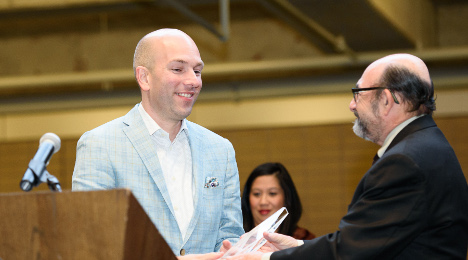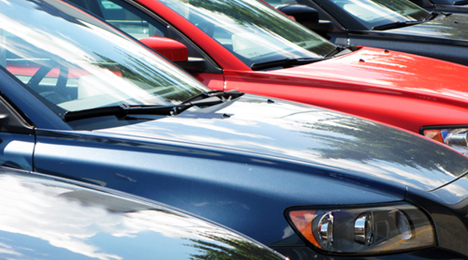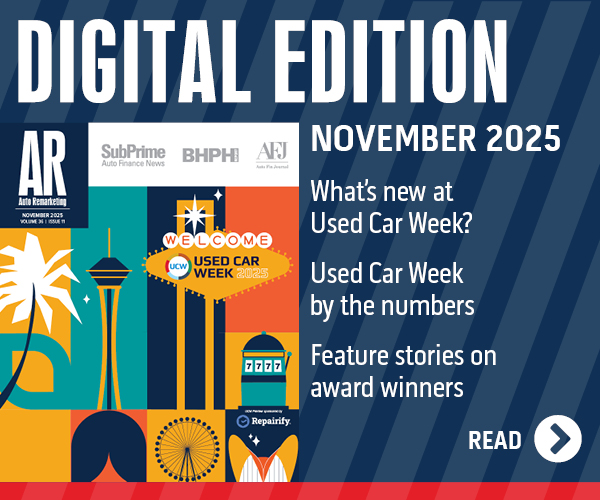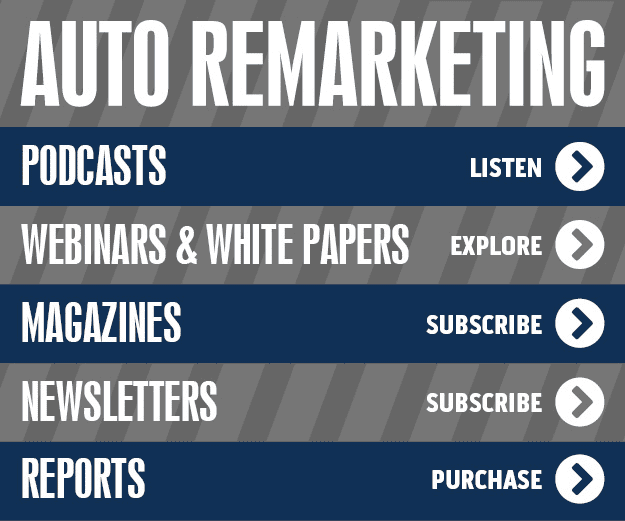AIM Group, an interactive media and classified advertising consultancy firm, claims in a report that via “an unusual business model” CarGurus has leapfrogged Autotrader.com and Cars.com to become traffic leader among automotive advertising sites in the U.S.
In its 2017 Automotive Advertising Annual report, the AIM Group highlighted that it explores how “this low-profile company blew past the established market leaders.”
In a four-page case study about the growth of CarGurus, AIM Group’s Classified Intelligence Report auto annual examines its funding, its tactics, its business model and its future.
The 65-page annual report covers 30 countries and 100 companies. It profiles 35 disruptive auto advertising start-ups, and includes an "innovation roundup" of 58 steps taken in 2016 by established auto ad companies to strengthen their business. The report also includes a bonus of non-auto content in a "mini" edition of Classified Intelligence Report.
“Conventional wisdom says 'winner-takes-all' in classified advertising, but CarGurus has proven that a creative business model and a focus on end-users can up-end the market leaders," said Rob Paterson, AIM Group director of consulting.
“As CarGurus expands internationally, it will challenge well-established auto ad sites in markets like the U.K., Canada and Germany. Our report explores the competition in those countries and what CarGurus has been doing and plans to do in 2017 to attack the competition,” Paterson continued.
The report also covers the ways horizontal classified sites covering all categories have expanded their listings from auto dealers, and how a site redesign at a Russian auto site tripled traffic.
“The pace of innovation at auto sites is increasing, and this report can serve as a road map to the changes that can make a big difference to classified sites — whether they’re automotive or other classifieds,” Paterson said.
The report is available for $1,495 from AIMGroup.com, where a free preview edition is offered for download here. AIM Group said the report comes with a money-back guarantee.
Dealerships are losing an average $380,000 annually in service revenue as a result of missed opportunities to digitally engage with and retain millennial car buyers, according to a study released by AutoLoop on Tuesday.
As the purchasing power of this key demographic expands, modifications to digital engagement strategies will be required to increase low millennial retention rates, says the provider of auto industry marketing and customer relationship management solutions.
AutoLoop's 2016 Digital Engagement study suggests that significant gaps in dealership service experience has resulted in a service customer retention rate 12 percent lower than previous generations, as well as a customer referral rate 50 percent lower.
"By 2020, millennials will command $1.4 trillion annually in purchasing power and represent 30 percent of total retail sales, so it's important that dealerships know how to win their business," Doug Van Sach, AutoLoop vice president of analytics and data services, said in a news release. "Although millennials as a whole are more brand-fickle than other generations, it's a mistake to believe they are incapable of becoming loyal customers. Our research uncovered opportunities in several key areas for dealers to better cater to this elusive demographic."
The survey revealed that dealers have notable shortcomings in three key areas, according to AutoLoop.
-
Insufficient online presence for service department
-
Lack of digital engagement (with tools such as online scheduling, mobile apps, SMS/text notifications and eCommerce)
-
The in-store service experience
"Dealers need to dramatically increase digital and mobile advertising for their service business, particularly on third-party websites," said Van Sach. "If they don't, they risk losing millennial shoppers to competitors, especially tire retailers and quick lube chains."
Millennials are seven times more likely than other generations to be swayed by a digital ad, according to AutoLoop.
The company found that 41 percent of millennials were influenced by a digital ad before their last service visit and that 75 percent of millennials are highly influenced by online reviews, compared to 56 percent of Gen X-ers and 32 percent of baby boomers.
Thirty-seven percent of millennials prefer to make service appointments via a website or a mobile app, compared to 25 percent of Gen X-ers and 17 percent of baby boomers. But in spite of their preference, they are particularly less likely to make an appointment, according to AutoLoop.
"These results indicate that many dealerships are still not using online scheduling tools and, in particular, mobile scheduling," Van Sach said. "It's critical that dealerships integrate their marketing and appointment programs so they can convert more millennial service shoppers into customers."
According to AutoLoop, only 48 percent of millennials always make an appointment, whereas 57 percent of Gen X-ers and 69 percent of baby boomers.
“Despite the high level of digital research by millennials, dealers are routinely outspent by aftermarket companies in digital advertising — if they are visible at all,” AutoLoop said.
Millennial shoppers also prefer SMS communications from the dealers far more, according to the study. Sixty-six percent favor SMS/text notifications, while only 46 percent of Gen X-ers and 21 percent of baby boomers.
"Most dealers still don’t use SMS to keep customers informed throughout a service visit, and very few dealers have eCommerce options," said Van Sach. "Given these gaps in the digital experience, the lower service retention rates among millennials are no surprise."
Sixty-three percent of millennials said they would like to pay by phone, compared to 51 percent of Gen X-ers and 24 percent of baby boomers, according to the study.
Millennial respondents who participated in the study cited the following three reasons as to why they prefer to pay by phone:
-
Getting their vehicle faster (49 percent)
-
Avoiding the checkout process (35 percent)
-
Avoiding the service advisor (16 percent)
Another in-store experience gap AutoLoop points to is the presentation of inspection results.
Millennials lack of understanding of their inspection results has had a significant negative impact on referral rates.
Only 51 percent of millennials understand their inspection results, compared to 58 percent of Gen X-ers and 63 percent of baby boomers.
"Dealers need to focus on improving their in-store experience if they want to retain millennials' business and get more referrals," Van Sach said. "We recommend monitoring service advisors for process compliance and implementing technology that educates consumers and offers more choices, such as mobile tablets, service repair videos and pricing and financing options."
Additionally, AutoLoop’s findings suggest that millennials chose a service center for price and financing options far more often.
“This generation values being presented with different price and financing options for services,” AutoLoop said.
Thirty-two percent of millennials were found to choose a service center because of price and financing options — which is two times more than non-millennials — who are most likely to select a store due to their use of OEM parts and the expertise of technicians.
The 2016 AutoLoop Digital Engagement study surveyed 1,000 auto consumers and analyzed the purchase behavior of more than four million customers representing 1,000 dealerships throughout the U.S.
To view the study visit, http://autoloop.net/life-after-loyalty-whitepaper.aspx.
Last week, Cox Automotive executive vice president and chief marketing officer John Kovac accepted a lifetime achievement award from the Atlanta Chapter of the American Marketing Association (AMA) in recognition of his long-standing record of marketing achievements throughout his career.
Kovac was presented with his award at the 60th annual AMY Awards gala on Thursday at the College Football Hall of Fame in Atlanta.
“At Cox Automotive, we pride ourselves on teamwork and collaboration, so to me, this award represents the ingenuity and creative thinking of the hundreds of Cox Automotive marketing team members and agency partners that continue to push boundaries and innovate for our brands,” Kovac said in a news release. “I am thrilled to accept this award on behalf of our entire team.”
Kovac is known for his entrepreneurial spirit and his “make it happen” approach, the AMA said.
Currently, he leads more than 400 global marketing team members who are responsible for over 25 brands, including Autotrader, Kelley Blue Book, Manheim, Dealertrack and Dealer.com.
His 18-year career with Cox Automotive started when he became one of Autotrader's founding employees.
Kovac lead brand development and helped to oversee the production of Autotrader's first advertising campaign, “I Need a Car.”
Autotrader became a leading car shopping site under his leadership. The third-party car shopping site currently has more than 18 million unique visitors each month, according to the AMA.
“John continually demonstrates remarkable leadership and passion in everything he does,” said Sandy Schwartz, president of Cox Automotive.
“He embodies the entrepreneurial spirit that our company was built on. To have our most senior marketing leader recognized by the American Marketing Association is a tremendous honor — not just for John but for our entire organization.”
The AMA’s other honorees included local companies and agencies in 20 plus categories such as advertising, branding, digital marketing, analytics, market research and data visualization.
To view the full list of award winners, visit http://www.amyawardsatl.com.
PERQ announced Monday it launched Auto Website Conversion Course, a free series of online best practice tutorials designed to help dealers clean up their sites and create more potent conversion paths.
Decluttering dealership websites and directing attention to targeted messaging, along with personalized calls to action, can significantly increase click-through rates and lead data collection, according to the marketing technology provider.
“Most dealership websites are jammed with a cacophony of offers, messages and static lead forms that, more often than not, lack relevance to the visitor. It’s the equivalent of walking into a dealership and having multiple salespeople yelling offers and information at you all at once without bothering to ask what your name is, if you’re ready to buy or if you want a new or used vehicle,” Russ Chandler, PERQ product marketing manager, said in news release.
“It’s no wonder the average dealership website converts less than three percent of their traffic.”
PERQ’s analysis found that dealerships who declutter by offering a streamlined and interactive experience see a 42-percent increase in CTRs, a 15-percent profit lift and a five-fold increase of data collected on sales leads.
“These websites are not ‘bugging’ visitors with messages they have no interest in but, instead, target consumers based on their website behavior, dynamically adjusting what is pushed to them,” PERQ said.
Four declutter best practices PERQ advocates for dealer websites include the following:
-
Entice visitors to seek more useful information. It creates an opportunity to gather data that will help provide a more informed and streamlined sales experience.
-
Inventory CTAs and conversion tools to understand what works and what doesn't.
-
Analyze how effectively a CTA is converting.
-
Re-evaluate remaining CTAs and make informed decisions on which CTAs to display based on user behavior.
All data for PERQ’s analysis came from its FATWIN Web Engagement platform. It virtually trains dealership websites to have relevant, real-time conversations with visitors through dynamic interactions that change based on the consumer’s behavior.
Visit PERQ’s Auto Website Conversion course webpage for more information about its lesson plan.
For dealers who have found themselves grappling with limited ad dollars, mirroring OEM ad spending during seasonal events is a strategy that can help maximize campaign efforts throughout the rest of the year.
“Digital marketing has increased substantially over the past couple of years, all dealers are struggling to find ways to be competitive in their market,” James Grace, senior director of analytics products at Cox Automotive, said in a phone interview with Auto Remarketing.
“I think one of the most effective ways of them being competitive is really paying attention to what the OEMs are doing and where they are putting national ad dollars.”
As OEMs push lease incentives, financing deals, and cash-back offers during holiday weekends such as President's Day last month, dealers should follow the lead of automakers, says Grace.
Following the Super Bowl ad madness in January or early February, President’s Day weekend usually stimulates auto sales for the month.
During this President’s Day weekend, the dealership network for Dealer.com — a Cox Automotive company based in Burlington, Vt. — saw website engagement go up significantly compared to the first six weekends of the year, according to Grace.
“In this particular case around President’s Day, from a dealer website perspective, it was a record weekend,” said Grace.
There was a 19-percent increase in both visits and quality visits that weekend, compared to the first six weekends of the year and a 30-percent increase in average search attributed visits.
“The data continues to suggest that where there’s a higher level of coordination, communication and alignment, the results are better in terms of activity we see on websites as well as sales,” Grace said.
“We’re seeing a couple of interesting trends. One is around incentives and ad spend, where if we look across all of the different OEMs, in some cases there’s a positive correlation. Roughly two-thirds of the time there’s a positive correlation between OEM incentives and digital ad spend by dealers.”
Consumer web traffic, which is a sign that consumers are shopping for cars on dealers’ sites, demonstrates the power of a coordinating with OEM activities, he explained.
“As we’re tracking more and more of these seasonal events, whether it’s President’s Day, the Super Bowl or anything else, we’re definitely seeing an increase in the trend of additional traffic being driven by those events,” Grace said.
“Ultimately, I think dealers need to pay more attention to what the cadence is around them — from OEMS, companies like us and other places where there’s this kind of seasonal ad spend,” added Grace. “When you sort of pour a little a bit of dealer focused advertising into that mix the return you get for that dealer focused advertising is multiplied in the context of these larger national efforts.”
Jessica Stafford, vice president of marketing for Cox Automotive, agrees with Grace.
She saw a similar increase in web traffic following ad campaigns launched during NBA All-Star weekend.
“I think the combination of this specific ad campaign as well as the normal behavior that we see for weekends is why we want dealers to spend a little bit more thought around what their mobile strategy is, specifically around advertising and other ways of capitalizing on theses sort of seasonal trends that we see,” she said.
On the night of the game, Feb. 19, Cox Automotive's Autotrader brand had its highest mobile traffic day ever. The site reached an estimated 677,000 mobile sessions and 2.5 million mobile vehicle detail page views.
“The idea of leveraging the strength and the buying volume that’s out there from the bigger national advertisers is key,” Stafford said. “We see these trends and try to leverage them in order to drive even more consumers to their client’s listing.”
Mobile wholesale marketplace ACV Auctions has secured $15 million in venture funding in a Series B investment round led by Bessemer Venture Partners that the online auction platform will use to expand into additional markets.
ACV secured $5 million in venture capital last year in a round led by Tribeca Venture Partners. It won the 43North startup competition in 2015, pulling in $1 million.
ACV also secured $1 million in angel investment funds in 2015.
“More than 20 million used cars are bought and sold wholesale every year, mostly through physical auction sites,” Bessemer Venture Partners partner Bob Goodman said in a news release. “Dealers are ready to take their business online and eager to exploit ACV's dedicated marketplace of both supply and demand.
“Because it was built from the ground up with the needs of dealers in mind, we believe ACV has an opportunity to revolutionize the ways cars are sold in auction,” said Goodman, who will join ACV’s board.
Bessemer has had some focus in marketplace companies and cloud/SaaS startups, which made ACV attractive.
“We know great companies when we see them,” said Goodman.
ACV recently expanded into Northeast Ohio, Eastern Massachusetts and Washington, D.C. Its operations also include the Buffalo, Rochester, Syracuse, Binghamton and Albany areas of New York, plus Pittsburgh, Northern New Jersey and Western Massachusetts. This year, ACV plans to continue growth along the East Coast and into the Midwest.
Incentives are offered to the first major dealer group signing up in each market. It currently has more than 60 employees and plans to add more than 100 each year “for the foreseeable future,” the company said.
“Our innovative auction platform, and the high value it provides to dealers, continues to attract customers and investment from leading venture capital firms,” ACV chief executive officer George Chamoun said in a news release.
“Our investment in technology and superior condition reports — both are a hallmark of our service — will continue to drive down costs for dealers and improve transparency for wholesale vehicles. Bessemer Venture Partners is one of the top investors in the country and will add tremendous value to our rapid market expansion.”
CompetitorPro announced that Eric Cotter — former TrueCar vice president of used car product — has joined chief executive officer and founder Steve Greenfield, who started the company in August as the co-founder.
In January, Greenfield introduced the CompetitorPro product to dealers at the NADA Convention & Expo.
CompetitorPro is an intelligence solutions tool designed just for automotive dealerships. It uses complex algorithms to summarize insights to provide dealer clients with useful analytics and actionable recommendations.
"Eric is one of the strongest industry players that I know," Greenfield said in a news release.
"Given his extensive industry connections and his vast history of automotive product development for consumers and dealers, Eric was an ideal choice to join CompetitorPro as we look to accelerate into the next critical phase in our growth story."
Currently, Cotter oversees all product management, marketing and sales within the company.
At TrueCar, he was responsible for cultivating consumer and dealer products for the company’s used car shopping and trade-in experiences.
"While the push for consumer transparency over the past 20 years has given the market great efficiencies and consumer confidence, car dealers are still left making complex operational decisions with only 'fuzzy' market averages & aged sales/registration reports," Cotter said. "The foundation that Steve and team have built give us a unique ability to address several challenges and frustrations facing car dealers each day. Together we will build on this foundation and enable dealers to make the most informed decisions with a competitive edge that was never possible before now."
Before his role at TrueCar, Cotter served as vice president of automotive product and innovation at Credit Union Direct Lending and senior product manager of Innovation for Kelley Blue Book.
For more information about the new product or a demo, visit www.CompetitorPro.com.
“The used market as a whole is definitely in the midst of a significant transition that’s only just starting to accelerate.”
That above quote from Edmunds senior analyst Ivan Drury is one of the last sentences in a news release accompanying the company’s latest Used Vehicle Market Report.
But it might be the most apt way to describe what’s happening in the pre-owned market, particularly the vehicle makeup, which is getting rapidly younger and more expensive.
There will likely be less than 6 million trade-ins (which average 6 years in age) for the first time in five years, while off-lease volumes are expected to break records, according to Edmunds.
The average age on the 11.6 million used cars that franchised dealers sold last year was an all-time low of 4.1 years, according to Edmunds. Vehicles ages 3 and under represented nearly two-fifths (58 percent) of franchised dealer used-car sales last year, with off-lease cars driving this push.
Average used transaction prices were at $19,189, an all-time high.
“While low interest rates and consistent values are making it possible for the market to absorb these newer, more expensive off-lease vehicles, demand for older, less expensive used vehicles hasn’t waned,” Drury said. “Fewer older vehicles available puts sellers at an advantage, particularly those looking to sell vehicles that are in high demand like trucks and SUVs.”
The report also points out that nearly every segment of 8- to 15-year-old vehicles had higher value retention last year. All told, it was a year for “dramatic change.”
“Record 2016 transaction prices reflected a used market that’s undergoing dramatic change. Growing numbers of 3-year-old off-lease vehicles, more 1- to 2-year-old rental returns and a consistent flow of near-new trade-ins made a big impact,” Edmunds said in its report. “A record-high 58 percent of the used vehicles sold at franchise dealerships were 3 years old or newer.”
Where does it go from here? Well, consider that lease originations climbed 10.6 percent in 2014, were close to 4 million in 2015, were well past 4 million in 2016 and are expected to reach 4.1 million this year.
And off-rental vehicles — which “consistently feed the near-new category,” Edmunds says — should help the push towards a younger used-vehicle fleet, as well.
Edmunds said that with rental companies upping purchases in recent years, 1- and 2-year-old off-rental cars in the used market should continue to have a strong presence in the market.
Here's one thing to keep in mind about a younger used-vehicle fleet, though: incentives on the new-car side can throw a wrench into the mix.
“The drop in average vehicle age led to higher prices in nearly all categories,” Edmunds said in the report. “While newer used vehicles have fewer miles and less wear, there is a downside. Their value (and demand) can be lowered significantly if manufacturers offer big incentives on similar new vehicles.”
And if you're looking for an encouraging sign from the report, here's one: On a year-over-year basis, off-lease volume was up as much as 50,000-plus units in some segments last year, yet overall prices were steady with 2015.
“From 2013 to 2014, lease volume increased 10.6 percent — partially driven by demand for popular vehicle categories, including compact crossovers, large SUVs and large trucks,” the report said. “We expect this to keep transaction prices higher into 2017.”
During Super Bowl LI on Sunday, media, insights and marketing solutions company Jumpstart Automotive Media monitored auto shoppers visiting its portfolio of publishers in a time-trended series to see how traffic fluctuated when ads aired.
Alfa Romeo, Ford, and Kia saw the highest share of traffic throughout the game according to the data and insights published in company’s annual advertising performance report released on Tuesday.
Alfa Romeo, the top performing brand of the night, aired three commercials during the game.
“One minute after the first commercial aired, overall site traffic increased tenfold, and four of the top five searched terms included Alfa Romeo. After the second commercial aired the site reached its highest numbers in traffic and eight out of the top ten searched terms included Alfa Romeo,” said Jumpstart in a news release.
In a seperate analysis, Cars.com reported a 1,179-percent spike in online traffic for the Italian car brand’s pages.
Meanwhile, Jumpstart indicated that the most popular Alfa Romeo model searched for was the Giulia.
“The Super Bowl is one of the most exciting categories for brands to go after, and this year’s auto advertisers made especially impressive moves,” said Jumpstart vice president of marketing and strategic insights Libby Murad-Patel in a news release.
“Of course, it’s not unusual for automakers to weave current events and themes into their Super Bowl spots, but we saw this year’s advertisers take that concept to a whole new level—especially on the political front. From Ford (mobility) and Kia (eco-consciousness) to Audi (equality) and a never-before-seen post-game production from Hyundai, these brands built new experiences, connected with consumers in new ways, and proved that the love of cars and driving really is stronger than ever.”
The five brands that drove the top increases in traffic also had the highest share of active pages viewed in the two minutes following the run of their ad.
Below is Jumpstart's recap:
Alfa Romeo Giulia "Dear Predictable"
Length of spot: 30 seconds
Placement in game:Fourth Quarter
Share of active pages: 60%
Ford "Go Further"
Length of spot: 90 seconds
Placement in game: Between coin toss and kickoff
Share of active pages: 40%
KIA Niro "Heroes Journey"
Length of spot: 60 seconds
Placement in game:Third auarter
Share of active pages: 28%
Lexus LC 500 "Man & Machine"
Length of spot: 30 seconds
Placement in game: Second quarter
Share of active pages: 25%
Mercedes-AMG GT Roadster “Easy Rider”
Length of spot:30
Placement in game: Third quarter
Share of active pages: 10%
Did you punch in the search term “Alfa Romeo” during Sunday night’s Super Bowl?
If so, you probably weren’t alone.
Online traffic for the Italian car brand — one of nine automakers to air ads during the game, according to Cars.com — skyrocketed, say analyses released Monday.
There was a 1,179-percent spike in visits to Alfa Romeo pages on Cars.com in the eight minutes after the car brand’s Super Bowl ad (versus the same time period before the spot), Cars.com said in a news release.
Meanwhile, the model page on Cars.com for the Alfa Romeo Giulia showed a 7,320-percent increase in traffic compared to the previous four Sundays. The next closest was the Audi S5 with a 1,391-percent hike.
In commments provided by Cox Automotive, Dealer.com director of digital marketing Andy MacLeay said: “FCA played aggressive offense with Alfa’s re-launch to the U.S. market, putting up three dedicated spots that were likely a first introduction to the brand for many younger Americans.
“Traffic spikes on both Google and the Dealer.com network showed the ads were effective in driving interest for the brand. Great comeback for Alfa Romeo as a brand, in what turned out to be the greatest comeback game in Super Bowl history.”
Edmunds said in an analysis that Alfa Romeo was the big winner on a brand level.
Its traffic on Edmunds climbed 785 percent throughout the game, the site said. On the model level, traffic to the Giulia page at Edmunds was up 802 percent, good for third place behind the Lexus LC (up 1,710 percent) and the Kia Niro (up 869 percent).
“Using the Super Bowl to generate awareness for a new brand or product is a tried-and-true advertising tactic, and this year proved it still works,” Jessica Caldwell, executive director of industry analysis for Edmunds, said in a news release.
“If you think about what it takes for someone to look away from an exciting game or halftime show to go online and research something, odds are it’s because it’s something they’ve never heard of and they’re compelled to find out more,” she said. “These ads could have been the first time many consumers saw models like the LC or the Niro, and Alfa Romeo is still a very new brand to many in the U.S.”
Behind the Alfa Romeo on the list of auto brands with biggest Super Bowl lifts on the Edmunds site were Kia (up 63 percent), Mercedes-Benz (up 9 percent) and Lexus (up 8 percent).
Edmunds points out that some brands didn’t see full-game spikes, but did realize immediate jumps when their ads aired; the Honda CR-V, for instance, had a 6-percent increase after its second-quarter ad, with the brand’s traffic showing a 14-percent bump.
Point is, all is not necessarily lost for a brand just because full-game traffic doesn’t rise meteorically.
“It’s harder for the volume brands to show large lifts in traffic because they’re working off of such a high baseline. Even minor gains are a victory, as those small percentage points represent a high number of shoppers expressing interest,” Caldwell said.
“Despite the fact that many marketers are shifting their media spend away from traditional TV, the big game still proves to be an effective way for automakers to grab the attention of car shoppers,” she said.
And that attention often is being driven to the smartphone, according to Cars.com.
Close to 60 percent of its visits were on mobile devices on Super Sunday, data strategy manager David Greene said in a news release.
“Because of the sheer audience size, the Big Game continues to be an effective advertising method, however, when paired with online digital support, the impact is even greater,” Greene said. “On mobile alone, there was a 1,074-percent increase to brand model pages advertised during the game.”
(Cars.com said it gathered internal data in real-time and compared it to site visits from the previous four Sundays.)
Turning to the Cox Automotive sites, as far as immediate impact, shopping activity on the Autotrader website for the Alfa Romeo brand (all searches) was up 3,811 percent the hour after the ad ran (compared to an hour before the game), Cox Automotive said.
Meanwhile, research activity for the brand on the Kelley Blue Book site was up more than 5,000 percent (measured as a fuction of new-car visits during the ad run against the prior hour).
Both measures led all brands.
As for post-airtime traffic volume, Alfa Romeo ranked second on a brand level for shoppping activity behind Ford on Autotrader (measuring all searches), and third behind Honda and Ford on KBB.com (measuring just new-car visits).
Those were calculated from traffic volume the hour after commercial airtime. Alfa Romeo was calculated as an average of all three of its spots, and Ford was an average of each of its airtimes.
On a model level, the Giulia's three spots ranked Nos. 3-5 in terms of immediate impact for shopping activity on Autotrader behind the Lexus LC 500 and the Buick Cascada on Autorader (comparing all searches an hour after the ad ran versus an hour before the game).
They ranked Nos. 1-3 on KBB (measured as new-car visits the ad run hour versus the prior hour). The LC 500 is not yet available on KBB.
For post-airtime traffic, the second Giulia spot was No. 1 on Autotrader's shopping actvity ranking (all searches), with the third Giulia spot at No. 2 and the first Giulia spot at No. 4. For KBB activity (just new-car visits), the second Giulia spot was No. 1, with the third Giulia spot at No. 3 and the first Giulia spot at No. 5.
“Automotive advertising that focused on new models and aspirational models have traditionally done well in previous years, and this year was no exception,” said Rick Wainschel, vice president of customer analytics and insights for Autotrader and KBB, in comments provided by Cox Automotive.
“The models that were both new and aspirational — Lexus LC500 and Alfa Romeo Giulia — performed particularly well in generating online behavior.”












